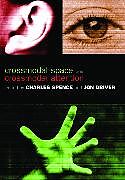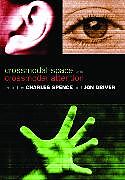Crossmodal Space and Crossmodal Attention
Einband:
Kartonierter Einband
EAN:
9780198524861
Untertitel:
Englisch
Autor:
Charles (EDT) Spence, Jon (EDT) Driver
Herausgeber:
OUP Oxford
Anzahl Seiten:
340
Erscheinungsdatum:
08.04.2004
ISBN:
0198524862
The first overview of how inputs from multiple sensory systems are integrated in the brain Many organisms possess multiple sensory systems, such as vision, hearing, touch, smell, and taste. The possession of multiple ways of sensing the world offers many benefits. However, combining information from different senses also poses many challenges for the nervous system. In recent years there has been dramatic progress in understanding how information from the different senses gets integrated in order to construct useful representations of external space. This volume brings together the leading researchers from a broad range of scientific approaches to present the first overview of this central topic in cognitive neuroscience.
Zusatztext This book... is an excellent way to find out about recent developments in this area... I found this book fascinating, highly stimulating and enjoyable, and highly recommend it to anyone interested in perception and/or neuropsychology. Klappentext Many organisms possess multiple sensory systems! such as vision! hearing! touch! smell! and taste. The possession of such multiple ways of sensing the world offers many benefits. These benefits arise not only because each modality can sense different aspects of the environment! but alsobecause different senses can respond jointly to the same external object or event! thus enriching the overall experience-for example! looking at an individual while listening to them speak. However! combining the information from different senses also poses many challenges for the nervous system. Inrecent years! there has been dramatic progress in understanding how information from different sensory modalities gets integrated in order to construct useful representations of external space; and in how such multimodal representations constrain spatial attention. Such progress has involvednumerous different disciplines! including neurophysiology! experimental psychology! neurological work with brain-damaged patients! neuroimaging studies! and computational modelling. This volume brings together the leading researchers from all these approaches! to present the first integrativeoverview of this central topic in cognitive neuroscience. The first overview of how inputs from multiple sensory systems are integrated in the brain Zusammenfassung The possession of multiple ways of sensing the world offers many benefits. Combining information from different senses also poses many challenges for the nervous system. This title presents an overview of how information from the different senses gets integrated in order to construct useful representations of external space. Inhaltsverzeichnis 1: Andrew King: Development of multisensory spatial integration 2: Barry E Stein, Terrence R Stanford, Mark T Wallace, J William Vaughan and Wan Jiang: Crossmodal spatial interactions in subcortical and cortical circuits 3: Michael S A Graziano, Charles S Gross, Charlotte S R Taylor and Tirin Moore: A system of multimodal areas in the primate brain 4: Elisabetta Ladavas and Alessandro Farne: Neuropsychological evidence for multimodal representations of space near specific body parts 5: Yale E Cohen and Richard A Andersen: Multimodal spatial representations in the primate parietal lobe 6: Alexandre Pouget, Sophie Deneve and Jean-Rene Duhamel: A computational neural theory of multisensory spatial representations 7: Paul Bertelson and Beatrice de Gelder: The psychology of multimodal perception 8: Jon Driver and Charles Spence: Crossmodal spatial attention: evidence from human performance 9: Martin Eimer: Electrophysiology of human crossmodal spatial attention 10: Emiliano Macaluso and Jon Driver: Functional imaging of crossmodal spatial representations and crossmodal spatial attention 11: Charles Spence, John McDonald and Jon Driver: Exogenous spatial-cuing studies of human crossmodal attention and multisensory integration ...
Vorwort
The first overview of how inputs from multiple sensory systems are integrated in the brain
Klappentext
Many organisms possess multiple sensory systems, such as vision, hearing, touch, smell, and taste. The possession of such multiple ways of sensing the world offers many benefits. These benefits arise not only because each modality can sense different aspects of the environment, but also
because different senses can respond jointly to the same external object or event, thus enriching the overall experience-for example, looking at an individual while listening to them speak. However, combining the information from different senses also poses many challenges for the nervous system. In
recent years, there has been dramatic progress in understanding how information from different sensory modalities gets integrated in order to construct useful representations of external space; and in how such multimodal representations constrain spatial attention. Such progress has involved
numerous different disciplines, including neurophysiology, experimental psychology, neurological work with brain-damaged patients, neuroimaging studies, and computational modelling. This volume brings together the leading researchers from all these approaches, to present the first integrative
overview of this central topic in cognitive neuroscience.
Zusammenfassung
The possession of multiple ways of sensing the world offers many benefits. Combining information from different senses also poses many challenges for the nervous system. This title presents an overview of how information from the different senses gets integrated in order to construct useful representations of external space.
Inhalt
1: Andrew King: Development of multisensory spatial integration
2: Barry E Stein, Terrence R Stanford, Mark T Wallace, J William Vaughan and Wan Jiang: Crossmodal spatial interactions in subcortical and cortical circuits
3: Michael S A Graziano, Charles S Gross, Charlotte S R Taylor and Tirin Moore: A system of multimodal areas in the primate brain
4: Elisabetta Ladavas and Alessandro Farne: Neuropsychological evidence for multimodal representations of space near specific body parts
5: Yale E Cohen and Richard A Andersen: Multimodal spatial representations in the primate parietal lobe
6: Alexandre Pouget, Sophie Deneve and Jean-Rene Duhamel: A computational neural theory of multisensory spatial representations
7: Paul Bertelson and Beatrice de Gelder: The psychology of multimodal perception
8: Jon Driver and Charles Spence: Crossmodal spatial attention: evidence from human performance
9: Martin Eimer: Electrophysiology of human crossmodal spatial attention
10: Emiliano Macaluso and Jon Driver: Functional imaging of crossmodal spatial representations and crossmodal spatial attention
11: Charles Spence, John McDonald and Jon Driver: Exogenous spatial-cuing studies of human crossmodal attention and multisensory integration

Leider konnten wir für diesen Artikel keine Preise ermitteln ...
billigbuch.ch sucht jetzt für Sie die besten Angebote ...
Die aktuellen Verkaufspreise von 6 Onlineshops werden in Realtime abgefragt.
Sie können das gewünschte Produkt anschliessend direkt beim Anbieter Ihrer Wahl bestellen.
Loading...
Die aktuellen Verkaufspreise von 6 Onlineshops werden in Realtime abgefragt.
Sie können das gewünschte Produkt anschliessend direkt beim Anbieter Ihrer Wahl bestellen.
| # | Onlineshop | Preis CHF | Versand CHF | Total CHF | ||
|---|---|---|---|---|---|---|
| 1 | Seller | 0.00 | 0.00 | 0.00 |
